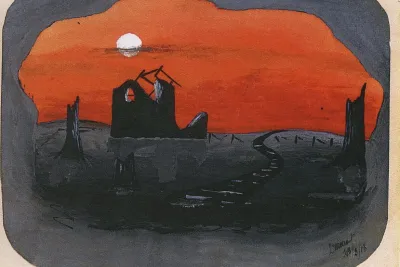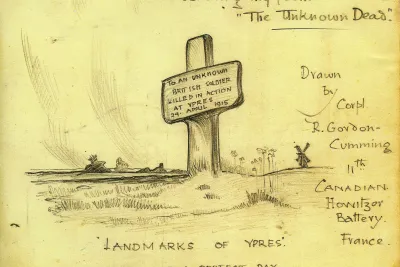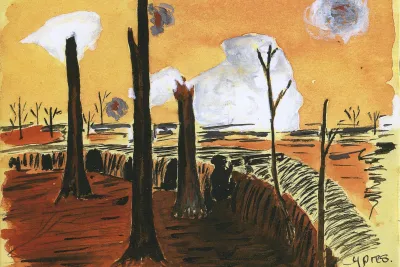Oh, Oh, Oh, It's a Lovely War:
Gladys Matheson's Memories as a Nursing Sister
Over one hundred years have passed since the conclusion of the First World War and Canadians today still recognize the sacrifices made during one of the largest conflicts of the twentieth century. Housed at the Provincial Archives of Saskatchewan are records created by Nursing Sister Gladys Elizabeth Crim (née Matheson). Her records include photographs, diaries, and an autograph book that document her service as a Nursing Sister with the Canadian Army Medical Corps from 1917 to 1919 as well as audio recordings recounting her experiences recorded decades afterward.
These records provide a unique glimpse into a time that no longer has any living veterans to share their firsthand accounts. Records such as Gladys’ that have been preserved in archives are important because they ensure that the history of duty, loyalty, and bravery demonstrated during the First World War will continue to be remembered and commemorated for generations to come.
A virtual presentation accompanies this exhibit and is available on YouTube: Nursing Sisters of the First World War.

Gladys Matheson in one of the huts that made up No. 3 Canadian General Hospital near Boulogne, France in 1918. PAS Photo R-B11319, p. 18.
Beginnings
Gladys Elizabeth Matheson was born September 27, 1892 at the Onion Lake Mission in the North-West Territories to Anglican missionaries, Rev. John R. Matheson and Dr. Elizabeth Beckett Matheson (née Scott).
In 1903, Gladys attended the Battleford Industrial School and, in 1906, was sent to Eastern Canada for further schooling that was not available in Saskatchewan at the time. In 1911, she returned to Saskatchewan and began nurses training in Prince Albert. However, seven months later, she ended her studies and returned to the Mission at Onion Lake as she felt she was needed there. For three years Gladys worked with her mother at the Mission’s hospital and as a schoolteacher at the school. In 1914, Gladys enrolled in nurses training at the Winnipeg General Hospital.
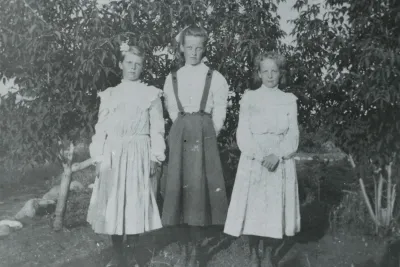
Gladys (center) with sisters Letitia and Riema in Onion Lake in 1906. PAS Photo R-A17776.
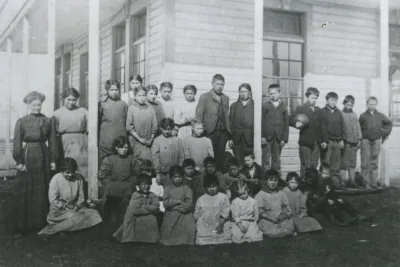
Gladys (far left) as a teacher at St. Barnabus Anglican Mission School in Onion Lake in 1912. PAS Photo R-A17705.
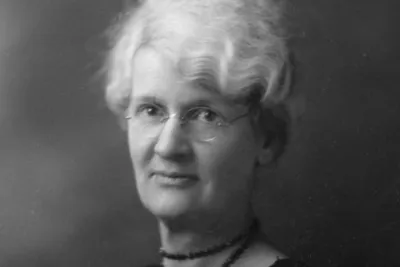
Portrait of Dr. Elizabeth Matheson.
PAS Photo R-A17686.
Amongst Gladys’ records are two photographs of her in both duty and street nursing uniforms while training in Winnipeg. Gladys described her nursing uniforms in her audio recordings:
“We wore light blue uniforms for duty, with white aprons that were stiffly starched, and veils over our hair. Our street uniforms were navy blue – long skirts, and tunics with wide brown belts and fitted collars on which we wore medical insignia… when we wore our capes… the wind would whip those about, or we would throw them back to show the lovely scarlet lining. In cold weather, we wore long navy-blue greatcoats."
- Gladys Matheson, R-E1395
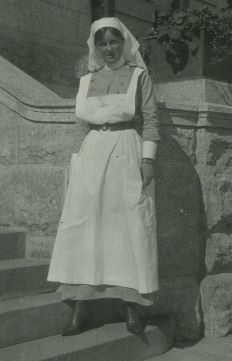
Gladys in duty nursing uniform.
PAS Item R-A26764.
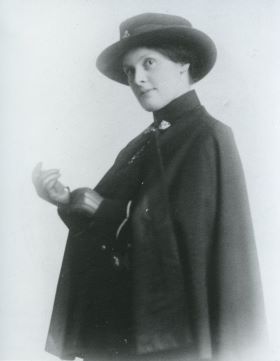
…and in street nursing uniform in 1917.
PAS Photo R-A17781.

Gladys’ graduating class from the Winnipeg General Hospital in 1917. PAS Photo R-D1684.
Military Service
Gladys successfully obtained her nursing certificate on May 23, 1917. Only two days later, Gladys enlisted for military service with the Canadian Army Medical Corps (CAMC) as a Nursing Sister. The CAMC recruited women who were British citizens and graduates of a recognized nursing program between the ages of 21 and 38. The army created a special officer rank for nurses, with the equivalent rank of lieutenant and title of “Nursing Sister.” Until the mid-1940s, Canada was the only country to commission women as officers. In total, 2,845 Canadian Nursing Sisters served with the CAMC during the First World War.
Gladys departed with the 25th Draft of the CAMC on December 21, 1917 aboard the S.S. Missanabie and arrived in Glasgow, Scotland on December 31. Gladys was assigned to work at No. 14 Canadian General Hospital in Eastbourne, England on January 8, 1918. She was assigned to the operating room, which had been the focus of her training in Winnipeg as she
"was quick and had firm and steady hands."
It was here that she saw for the first time the
“torn and mutilated bodies of strong young men from the awful battlefields in France"
and assisted in
“radical operations to save them from death, but often through the amputation of limbs, and seldom with hope that they could be restored to complete health.”
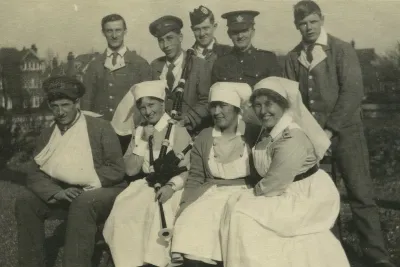
Gladys (holding the bagpipes) was stationed at No. 14 Canadian General Hospital in Eastbourne, England upon her arrival to Europe in early 1918. PAS Photo R-A26772.
On May 6, 1918, Gladys was ordered to serve at the No. 3 Canadian General Hospital in Boulogne, France. The “hospital” was a group of huts, with three huts making up one ward. While each hut was built to accommodate 25 patients, due to the heavy convoys of wounded men that were coming in from the casualty clearing stations near the front lines, men had to be crowded in wherever there was space. Gladys’ photographs are evidence that there was not always sufficient space.
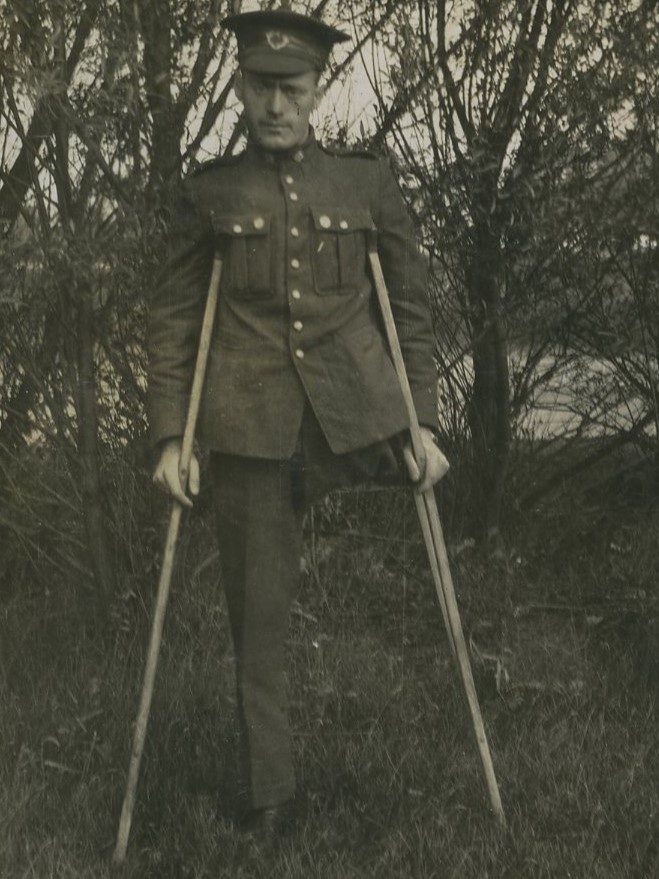
A soldier with amputated leg, presumably a patient of Gladys’. PAS Photo R-B11319.
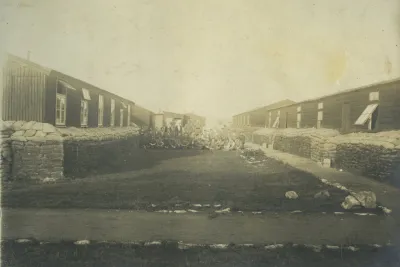
Gladys photographed the realities of the No. 3 Canadian General Hospital which did not have enough space for the amount of soldiers arriving for treatment in 1918. PAS Photo R-B11319, p.55.
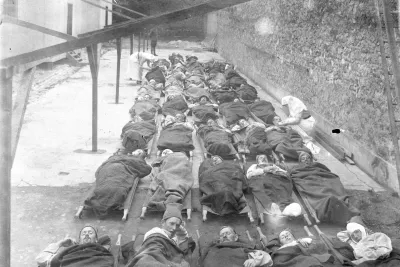
No. 3 Canadian General Hospital in 1918. PAS Photo R-B11319, p.85.
At least 58 nursing sisters died during the First World War, 21 of them from direct enemy action. Gladys described in her diary how on May 19, 1918, an air-raid aimed at Étaples killed two Canadian Nursing Sisters who were stationed at the hospital. One of the women, Margaret Lowe, had trained with Gladys at Winnipeg General Hospital. Gladys’ photo album includes photographs of the somber occasion of the nurses’ funerals.
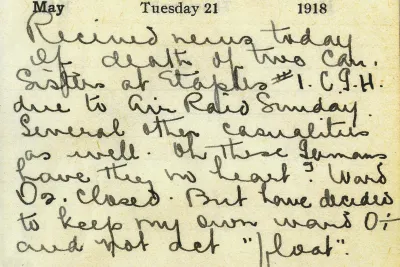
Gladys recorded the deaths of two Nursing Sisters during an air raid at Étaples, France on May 19, 1918. PAS Photo R-E1395.
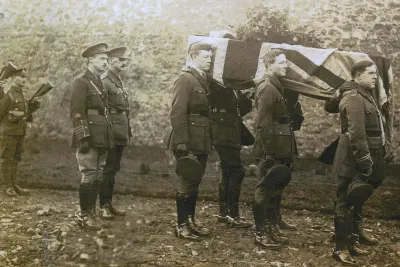
Gladys attended their funeral...
PAS Photo R-B11319, p.82.
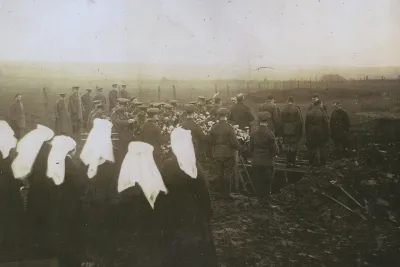
...and photographed the somber occasion.
PAS Photo R-B11319, p.83.
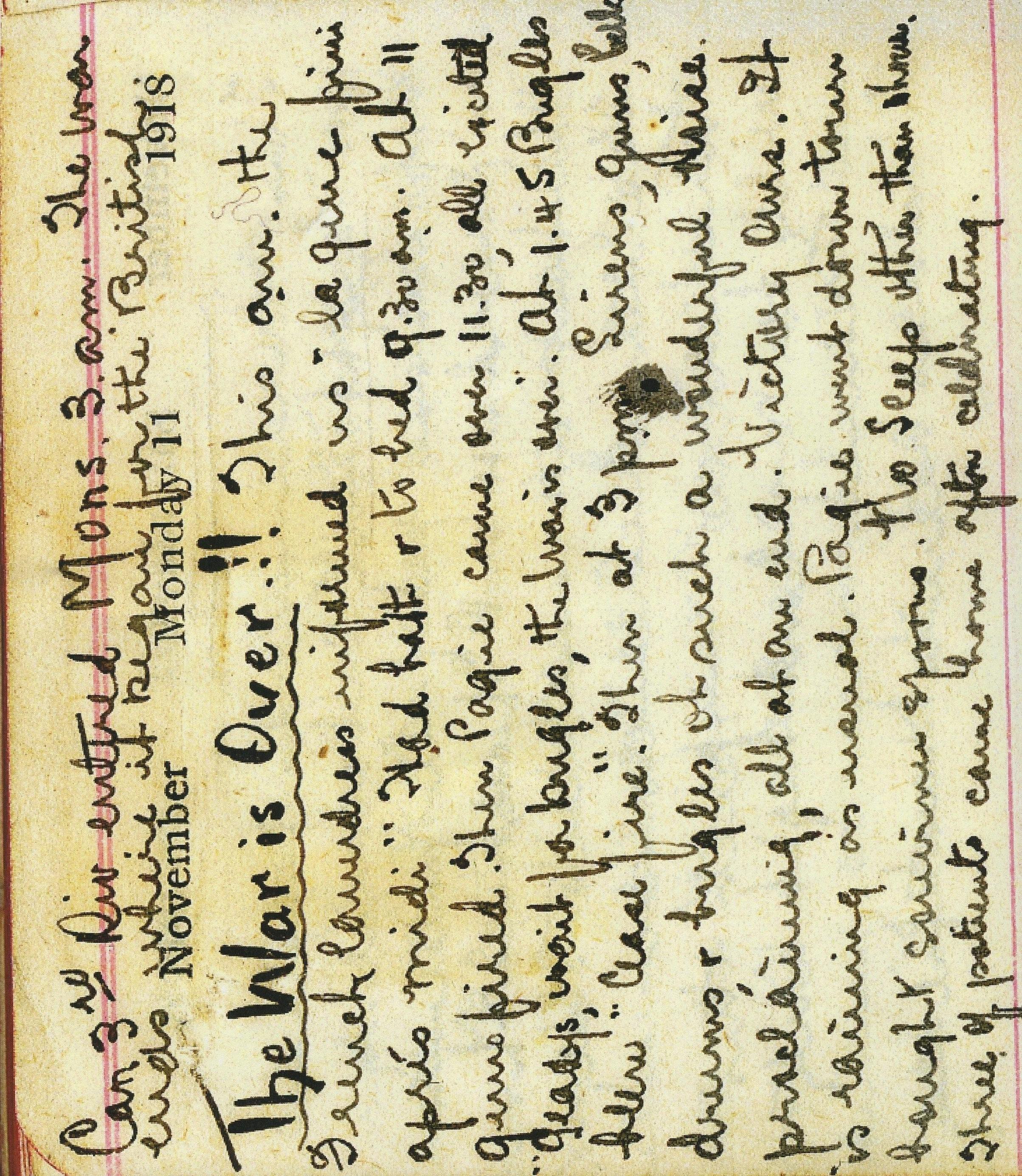
Gladys recorded the moment when she heard that the war had officially come to an end on November 11, 1918. PAS Photo R-E1395.
On November 11, 1918, despite having been on night-duty the night before and only having one hour of sleep, Gladys went to Boulogne to celebrate the end of the war with the other nurses, soldiers, and French civilians. She celebrated all day and then had to return to the hospital for another round of night-duty.
Gladys also remembers tending to a Private Lawrence who had had his leg amputated and was the last Canadian to be wounded in the war, just 15 minutes before cease fire sounded on Armistice Day.
Although the war ended on November 11, 1918, Gladys served in France until March 8, 1919 to tend to wounded men and patients suffering from the Spanish Flu. Gladys noted in her diary on November 5, 1918 that the
“flu is rampant.”
The influx of flu patients from the First Canadian division delayed the closing of the hospital which had been scheduled for March 1st. Gladys was disappointed because she thought she would be going home. However, being a patriot, she wrote,
“it’s for the Canadian Boys.”
Post-War
Gladys entered private nursing after the war, working in Winnipeg, Vancouver, and Hawaii. In 1926, Gladys married U.S. Infantry Officer Lieutenant Sterling M. Crim, who had been completing a tour of duty at Schofield Barracks in Hawaii. Crim remained a member of the military until he retired in 1946. The couple eventually settled down in San Antonio, Texas to be closer to Sterling’s family. Following her husband’s death, Gladys returned to Winnipeg in the 1980s, where she died on July 22, 1991.
Wartime Records
Gladys’ wartime records include diaries, photograph albums, an autograph book, and audio recordings of her reminiscences. The sketches and written entries in her autograph book (R-E1395) were made by the soldiers she cared for while in Europe.
